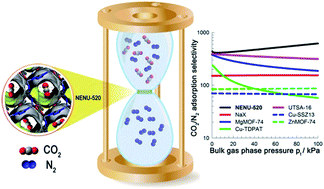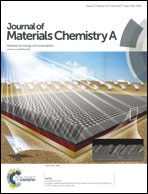A stable metal–organic framework with suitable pore sizes and rich uncoordinated nitrogen atoms on the internal surface of micropores for highly efficient CO2 capture†
Abstract
An air-stable tetrazolate-containing framework, [Zn2L2]·2DMF (NENU-520, H2L = 4-(1H-tetrazole-5-yl)biphenyl-4-carboxylic acid), with uncoordinated N atoms on its internal surface was solvothermally synthesized and structurally characterized. This metal–organic framework (MOF) exhibited high CO2 uptake of 79.9 cm3 cm−3 at 298 K and 100 kPa, as well as excellent adsorption selectivity for CO2 over CH4 and N2. Particularly, its exceptionally high selectivity of CO2 over N2 at 298 K has ranked NENU-520 among the highest MOFs for selective CO2 separation. Furthermore, the potential application of NENU-520 for the fixed bed pressure swing adsorption (PSA) separation of CO2 from CH4 and N2 has been validated via simulated breakthrough experiments. The small channel with the size of 3.6 Å, combined with CO2-accessible free nitrogen atoms directed toward the inner surface, is believed to contribute to its high CO2 uptake capacity and selectivity. Thus, this work represents a unique way to target MOF materials for highly selective CO2 separation by incorporating CO2-philic functional sites on pore surfaces, and at the same time optimizing pore sizes.


 Please wait while we load your content...
Please wait while we load your content...